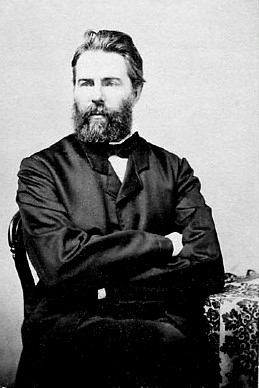143 Author Introduction — Herman Melville (1819-1891)
Herman Melville’s family seems to have given him some grounding in great events of early American history. His paternal grandfather participated in the Boston Tea Party; his maternal grandfather was a Revolutionary War hero. His parents also framed the material opportunities and dangers in American life. His mother Maria Gansevoort came from one of the richest families in Albany, New York. His father Allan Mellvill, however, had all of the appearance of prosperity with little of the substance. His Manhattan dry goods store went bankrupt; he left unpaid bills behind when he fled with his family to Albany. He apparently suffered a mental breakdown just before his death in 1832. The final “e” was added to the family name after his death.
Figure 1. Herman Melville, 1861

The freedom (or lack thereof) of the will; fate and destiny; surface and depth: these are themes that Melville (the final“e” was added to the family name after his father’s death) encountered early in his own life. These are universal themes given a distinct twist, or bent, by the great American experiment in democracy and freedom, by opportunities in this land of apparently unmatched resources, and by the underlying—perhaps unconscious, perhaps evil, probably selfish and ambitious—motives tyrannizing over and driving individual actions.
Despite whatever might have been Melville’s own wishes at the time, he was taken out of school when he was twelve so that he could earn a living and help support his family. He worked as a bank clerk and as a teacher, in his brother’s fur-cap store in Albany and on his Uncle’s farm in Pittsfield. In 1839, he lit out not for the wilderness but for a different frontier: the ocean. He served as a cabin boy on a ship bound for Liverpool. That city acquainted Melville with slum life, an experience he would later recall in his satirical novel Redburn (1849). In 1841, he served on The Acushnet, a whaler in the South Seas. The conditions of life on that ship caused Melville and a shipmate Richard Tobias Greene (b. 1825) to desert in the Marquesas Islands. The two spent a month among the Marquesan Taipis, supposedly cannibalistic islanders. After being retrieved by an Australian whaler, Melville enlisted in the United States navy as an ordinary seaman. After sailing the Pacific on the United States, he returned to Boston in 1844. On this voyage, he witnessed over 150 shipmates punished by flogging.
In 1846, he published Typee, a novel drawing upon his experiences on The Acushnet and at the Marquesas. Thereafter, Melville became known as the man who lived with cannibals. The book sold very well, as did his second novel Omoo (1847). His more philosophical third novel, Mardi (1849), did not sell well. He bolstered up his apparently-flagging writing career with Redburn and White- Jacket (1850), the latter exposing the cruelties suffered by men in the navy. In 1847, Melville married Elizabeth Knapp Shaw, daughter of the chief justice of the Massachusetts Supreme Court. With his father-in-law’s assistance, Melville settled with his family first in Manhattan then at a farm near Pittsfield, Massachusetts. His next work, Moby-Dick; or, The Whale (1851), should have confirmed his literary reputation. Instead, it almost ruined it.
In Albany, he lived near his friend Nathaniel Hawthorne who introduced Melville to other literary figures. Melville also immersed himself in reading Shakespeare; Milton; George Gordon; Lord Byron (1788–1824); John Keats; and Emerson. He grew ambitious for great American literature, asserting the ability of American writers like Hawthorne to rival Shakespeare. He himself sought not to write adventure stories but works of genius, to achieve an artist’s stance of engagement and detachment that gives as much energy and truth to an Iago as a Desdemona, as Keats said of Shakespeare’s art. In Moby-Dick, Melville follows Shakespeare’s lead through such disparate characters as Captain Ahab and Ishmael, exploring the mysteries of human nature, lifting the mask of appearance to reveal unfathomable truths—about nature, God, and death. But he leaves his readers to find their truths. Melville’s contemporary readers rejected the book.
His next book Pierre; or the Ambiguities (1852), ostensibly sought to appeal to female readers with a love story. It satirized hypocrisy, dishonesty, and sexuality (or perceptions of sexuality). It also failed. Melville turned to anonymously publishing short stories and novellas in Harper’s Magazine and Putnam’s Magazine at rate fees. He later collected them in The Piazza Tales (1856). In such works as “Bartleby the Scrivener,” “The Paradise of Bachelors and the Tartarus of Maids,” and “Benito Cereno,” he touched upon slavery, industrialization, and labor conditions. Melville revealed what Charles Dickens’s Stephen Blackpool called the “muddle” of a modern society that inverts good and evil and pulls even the brightest into the dark.
In his final years, Melville lectured, traveled to the Holy Land, wrote poetry on the Civil War, obliquely criticized Hawthorne in The Confidence-Man: His Masquerade (1857), and returned to a story of the sea in Billy Budd, Foretopman, a novella based on an actual incident in which a sailor may have been unjustly hanged.
Source:
Becoming America, Wendy Kurant, ed., CC-BY-SA
Image Credit:
Figure 1. “Herman Melville, 1861,” Unknown Author, Wikimedia, Public Domain.

